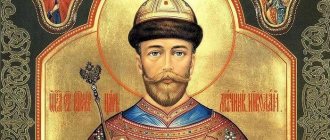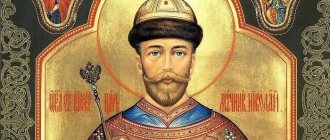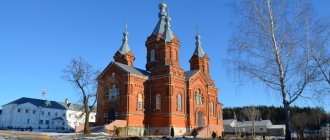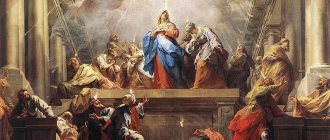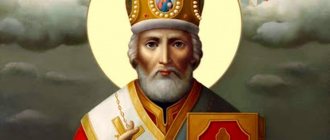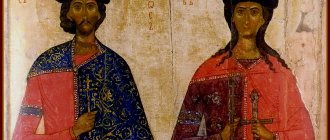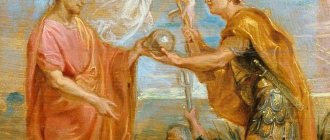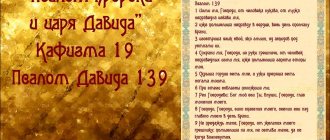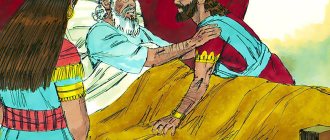- Royal passion-bearers - who are they?
- The last days of the Romanov monarchy
- Royal martyrs - the path of suffering
- Remembrance Day and Canonization of the Royal Family
- Prayer to the Royal Passion-Bearers
One of the cornerstones of Christianity is the veneration of saints. These are people who have been honored with extreme closeness to the Creator, examples of a virtuous life and prayerful intercessors of believers. Some of the righteous shone in the Heavenly Kingdom at the dawn of our era, while others - relatively recently. And our article will tell you just about such saints of the Lord! After reading it, you will learn why the Church glorifies the last All-Russian Emperor and his loved ones, what their icons look like and how commemoration is performed.
Imperial family
The last Russian monarch, Nicholas II, was born in 1868. He ascended the throne at the age of 26, after the sudden death of his father, Alexander III. He married the German princess Alice of Hesse, who was baptized into Orthodoxy with the name Alexandra and patronymic Fedorovna. Many foreign princesses and Grand Duchesses received this patronymic name at Baptism. It was given in honor of the miraculous Fedorov Icon of the Mother of God, especially revered by the Romanov family. The founder of the dynasty, Mikhail Romanov, was blessed by his mother to rule with this particular icon. In 1896, Nicholas II and his wife were officially crowned kings. They went down in history as royal passion-bearers.
Monument to the Royal Passion-Bearers in the Diveyevo Monastery
The royal couple had four daughters (Olga, Tatiana, Maria, Anastasia) and a son-heir, Alexei. He was born with a severe hereditary disease - hemophilia (incoagulability of blood). Even a minor physical injury could lead to Alexei bleeding and death. For example, at the age of eight, the prince hurt his leg during an unsuccessful jump into a boat. A hematoma formed that did not resolve for a long time. The heir was in a life-threatening condition. Nikolai noted in a letter to his mother that due to high fever and pain, Alexey could not sleep. The boy just moaned and prayed.
The royal family was friendly and united. She led a godly Christian life. There were no witnesses to the royal spouses quarreling or even raising their voices at each other. The emperor's daughters were not pampered and spoiled. They were engaged in handicrafts and strived to do good deeds. For example, during the war, the princesses and their mother looked after wounded soldiers.
Particular attention in the family was paid to prayer and church life. Even while under arrest, the princesses sang in the choir during services. Archpriest Afanasy Belyaev wrote in his diary:
“You have to see for yourself and be so close to understand and see how fervently, in the Orthodox manner, often on their knees, the former royal family prays to God. With what humility, meekness, and humility, having completely surrendered themselves to the will of God, they stand behind the divine services.”
Saints Romanovs: How did several representatives of the royal dynasty please God?
Today we will tell our readers about the supposed founder of the Romanov dynasty, who turned out to be one of the most famous holy fools in Rus'. About Emperor Alexander I, who defeated Napoleon Bonaparte, who, according to some researchers, renounced royal power and continued his life in Siberia under the name of Elder Fyodor Kuzmich.
You will also learn about the deeds of mercy of the Venerable Anastasia of Kyiv, the feat of kindness of the holy royal passion-bearers, the deeds of mercy of the Venerable Martyr Elizabeth Feodorovna and other martyrs who died in the mine near Alapaevsk.
Was Blessed Procopius of Ustyug at the origins of the family?
At the beginning of the 20th century, genealogy researchers who studied various historical documents, family trees of Russian nobles, lives of saints and other historical sources hypothesized that the ancestor of the Romanov family could be the first Russian holy fool - Blessed Procopius of Ustyug.
Andrei Ivanovich Kobyla, who lived in the 14th century, is the first representative of a number of noble families mentioned in historical documents. Mare had 5 sons: Semyon Stallion, Alexander Elka, Vasily Ivantey, Gabriel Gavsha, Fyodor Koshka. Four of them became the founders of noble families.
From Semyon Stallion came the Blues, Lodygins, Oblyazevs, Obraztsovs and Kokorevs. From Alexander Elka - the Sukhovo-Kobylins, the Neplyuevs, the Kolychevs (one of whom was the Hieromartyr Philip, Metropolitan of Moscow), the Khlyznevs, the Khludnevs, the Nemyatye, the Loshakovs. From Gabriel Gavsha - Boborykina.
Finally, Fyodor Koshka became the ancestor of the Koshkins, Zakharyins, Yakovlevs, Lyatskys, Yuryev-Romanovs, Bezzubtsevs and Sheremetevs. He is the distant ancestor of the last Russian emperor.
Since the end of the 18th century, the belief has been firmly established in genealogy that the father of Andrei Kobyla himself was a certain “Glanda Kambila Divonovich,” a descendant of a noble Prussian family. He allegedly, hiding from persecution by the crusaders, in the 13th century was forced to move to Veliky Novgorod, where he was baptized into the Orthodox faith under the name Ivan. At the same time, the nickname “Kambila,” which was unusual for Russian ears, was replaced by the consonant “Mary.”
The study by Mikhail Maltsev reports that Archpriest I. Kuznetsov, studying the life of the first Russian blessed Procopius of Ustyug, discovered that in his biography there are many overlaps with biographical data about Gland Kambile (Maltsev M. Holy Righteous Procopius of Ustyug - the founder of the Romanov dynasty: facts and fiction // Spiritual and moral education. - 2011. - No. 4).
Both of them came from German soil. Moreover, they chose Veliky Novgorod as their place of residence. Here they were baptized into the Orthodox faith. The time of their arrival also coincides - the 13th century. Moreover, in the life of Procopius, a lot of evidence was discovered that indirectly points to his princely dignity.
The future Saint Procopius grew up in wealth in the German lands. More familiar with Catholicism than with Orthodoxy, approx. with goods to Veliky Novgorod. Here he was struck by the piety of the local residents, the abundance and richness of churches and monasteries, the beauty of divine services and the sweet sound of church choirs.
He was touched to the depths of his soul, so that he no longer wanted to return to his homeland, he accepted Orthodoxy and began to look for a person who could teach him the dogmas of faith and the statutes of the Orthodox Church. Elder Varlaam Prokshinich from the Khutyn Monastery became his teacher.
After the ascetic’s instructions, the saint distributed all his property to the poor, and he himself became a novice at the monastery.
Novgorodians learned about the glorious ascetic and began to visit the monastery in large numbers to see him. Saint Procopius began to hear praise addressed to him and, fearing to lose his humility, he fled from the city to the east, where no one knew him.
This is how a blessed righteous man appeared in Ustyug, pretending to be insane, whose power of prayer and miracles over time revealed his holiness to the local residents. The Moscow Council of 1547 canonized the righteous Procopius and established his memory on July 8/21.
Holy Righteous Theodore of Tomsk (probably Emperor Alexander I)
In the fall of 1836, an unknown wanderer was detained near the city of Krasnoufimsk, Perm province. He attracted attention with his unusual appearance and inexplicable behavior.
What was striking was the discrepancy between the rough peasant clothes he was wearing and his majestic, handsome appearance, as well as the sophistication of his manners, which betrayed this man’s noble origin. He answered all questions reluctantly and evasively, which aroused suspicion among the peasants, by whom he was brought to the zemstvo court.
During interrogation, he reported the following about himself: Feodor Kozmin, 70 years old, illiterate, Greek-Russian Orthodox confession, single, not remembering his origins from infancy, lived with different people, and finally intended to go to Siberia. He did not have any identification documents with him.
Despite the extreme sympathy of the judges for him, according to the current legislation, he was beaten with 20 lashes for vagrancy and sentenced to exile to Siberia for a settlement. The holy righteous Theodore of Tomsk was pleased with the verdict.
As a result, the elder arrived in the Tomsk province, where he lived in several villages, and then settled in Tomsk itself. The righteous man attended divine services weekly, and also prayed a lot and often at home. Saint Theodore was extremely abstinent in food at ordinary times and strictly observed fasts.
Despite his fasts, the righteous man was stately, physically strong, tall, had a majestic appearance, a remarkably beautiful face, bright, always clean, blue eyes, curly hair on his head, a long, curly beard, completely gray.
It is known that through various wanderers, Theodore Kozmich conducted quite an extensive correspondence and was aware of all the main events in public life. It happened that he helped this or that person who turned to him in solving his everyday problems, handing him a letter in a sealed envelope to some important person, under the indispensable condition not to show the letter to anyone other than the addressee: “Or else you will be lost.” And the intervention of Theodore Kozmich, as they said, had the desired effect.
Saint Theodore taught peasant children to read and write, introduced them to the Holy Scriptures, geography and history. He captivated adults with spiritual conversations and entertaining stories from events in Russian history. All the information and teachings conveyed to them were distinguished by their depth and truthfulness, were remembered for a long time and led listeners to an understanding of the action of God's Providence in the destinies of great and small phenomena of human life and the surrounding world.
In his stories, the elder revealed an extraordinary knowledge of St. Petersburg court life and etiquette, as well as the events of the late 18th and early 19th centuries. He knew all the statesmen and gave them extremely accurate characteristics. He spoke with great reverence about Metropolitan Philaret and Archimandrite Photius, and also talked about Arakcheev and his activities, about military settlements, and recalled Suvorov. All such memories and judgments about people had some special - impartial and, at the same time, soft - character.
Most often, Elder Theodore loved to talk about military campaigns and battles, and sometimes, unbeknownst to himself, he would go into such small details, for example, in episodes of the War of 1812, that this caused bewilderment even among educated people: the clergy, intelligent exiles.
Glorification of Elder Theodore of Tomsk as a saint in 1984. Every year the memory of the holy righteous Theodore is celebrated on the day of his repose on January 20/February 5.
As you know, Emperor Alexander I the Blessed, who won the Patriotic War of 1812, officially died in Taganrog in 1925. Already during the life of Elder Theodore Kuzmich, rumors spread widely in Russia that the death of the autocrat was staged by him, and he spent his last years in repentance in Siberia.
It is interesting that at the beginning of the 21st century, the president of the Russian graphological society, Svetlana Semenova, and a number of handwriting experts stated that the handwritings of Alexander I and Fedor are identical.
Venerable Anastasia of Kyiv
By the decision of the Holy Synod of the Ukrainian Orthodox Church in 2009, nun Anastasia (Romanova) was canonized as a locally revered saint.
Alexandra Petrovna (1838-1900), eldest daughter of Prince Peter Georgievich of Oldenburg and Princess Theresa, was born in St. Petersburg. She was baptized according to the Protestant rite and received the name Alexander Frederick Wilhelmina.
In 1855, Grand Duke Nikolai Nikolaevich, the third son of Emperor Nicholas I, proposed to her. Before the wedding, the princess converted to Orthodoxy with the name Alexandra Petrovna. At first, the couple lived happily, but over time, the difference in interests led to a deep cooling of their relationship, since the princess constantly strove for God in her soul.
In 1879, the Grand Duchess became seriously ill and, having moved to Kyiv, began to realize her long-standing dream - the creation of a convent with numerous medical and charitable institutions, a “living monastery,” as she herself called it. The monastery was designed by Alexandra Petrovna’s son, Grand Duke Peter Nikolaevich.
In the monastery there were built: a cathedral, houses for the monastery sisters, a grandiose hospital, a hospital for incoming patients, a pharmacy, a school for orphan girls, a shelter for the blind, a shelter for incurable chronically ill women, a barracks for contagious patients, an anatomical chamber for the needs of the hospital, laundry and hospice. Mother actually became the predecessor of the Grand Duchess Elizaveta Feodorovna, and her Intercession Monastery became the prototype of the Marfo-Mariinsky monastery.
In 1889, the princess received a miraculous recovery from her illness and began to walk again. Then she took secret monastic vows with the name Anastasia and intensified her prayerful and ascetic deeds. She also often worked as a sister of mercy and as a nurse in the hospital at the monastery.
The Grand Duchess sold her jewelry and invested the proceeds in the construction and equipment of hospitals. In 1894, the Synod decided to annex the Mezhigorsky Monastery, which was then in complete decline, to the thriving Pokrovsky Monastery. Thanks to the efforts of the royal nun, this monastery also found a rebirth.
Mother’s feat of serving God and her neighbors lasted almost 20 years. At the end of her life, even when she was seriously ill, she constantly attended services and herself read the Six Psalms, the Hours, and the Canon. The Monk Anastasia of Kiev reposed in the Lord on April 13, 1900, on Bright Week.
Holy royal passion-bearers Emperor Nicholas II, Empress Alexandra and their children Alexei, Olga, Tatiana, Maria and Anastasia
The heir to Emperor Alexander III was born on May 6, 1868. Nikolai Alexandrovich received an excellent education with a military bias and from childhood was diligent in his studies and modest in everyday life.
In 1894, after the death of his father, Nikolai Alexandrovich ascended the Russian Throne and in the same year married the Hessian Princess Alix, who received the name Alexandra Feodorovna in Holy Baptism. The coronation celebrations were marred by several occasional tragedies, which were popularly perceived as ominous omens.
The Royal Couple had five children: daughters Olga, Tatiana, Maria, Anastasia and a son, the heir Alexey. The Tsar raised his children the same way he himself was raised - in the spirit of the Orthodox faith and folk traditions: the whole Family often attended divine services and fasted. Empress Alexandra, born into Lutheranism, embraced Orthodoxy with all her soul and stood out for her piety even among the Russian people. She loved long, orderly statutory services and always followed the progress of the service from books.
And the emperor and empress himself and their children always loved each other dearly and always tried to share common labors. The couple remained lovers both in sorrow and in joy and together overcame the most difficult trials of fate. Historians know more than 700 letters that reflect the tender relationship between the emperor and empress
The emperor's children showed sincere piety towards shrines and concern for the poor and sick. Tsarevich Alexei also took part in works of mercy, despite the severe genetic disease from which he suffered.
Emperor Nicholas preferred to wear a simple colonel's uniform in everyday situations; his son Tsarevich Alexei also liked to wear a military uniform, in particular an overcoat. The daughters and wife of the sovereign wore quite simple, but good-quality dresses in everyday life. The furnishings of their rooms were not “Spartan”, but also quite modest, in gray, white and green tones.
In the fall of 1891, when dozens of Russian provinces were exhausted from hunger, the then heir to the throne, Tsarevich Nicholas, became the head of the Committee for Famine Relief.
Having ascended the throne, the sovereign not only declared an amnesty for certain categories of prisoners and ordered in his own name to distribute small sums to the poor, but also provided significant assistance to needy scientists, writers and students. Even in peacetime, he donated about 4,000,000 rubles for the opening and maintenance of hospitals and clinics.
During the First World War, Emperor Nicholas II donated his personal 200,000,000 rubles, kept in a London bank, to the needs of the wounded, maimed and their families. He himself often visited not only military meetings and the front, but also the wounded in hospitals.
The imperial couple participated in the construction of dozens of churches and monasteries in Russia and around the world, donating their own funds for this, and took care of educating the people, creating a network of zemstvo, state and parochial schools. During the reign of Emperor Nicholas II, many Orthodox saints were canonized.
During the famine of 1898, Alexandra Feodorovna donated an eighth of the family's annual income to the starving people. She often transferred financial assistance to those in need through her close associates, trying, according to the gospel covenant, to keep this a secret.
The Empress organized charity bazaars, the proceeds from which went to help the sick, and organized training workshops for the poor throughout the country. Using personal funds, she opened a school of nurses and built a house for disabled soldiers of the Russian-Japanese War, where they learned various crafts.
During the war, Empress Alexandra Feodorovna gave away many of the halls and rooms of the Winter Palace as hospital premises, and she and her eldest daughters Olga and Tatyana performed the duties of sisters of mercy and cared for the wounded.
Later, Alexandra Fedorovna also began to patronize the infirmary in Tsarskoe Selo, the infirmary in New Peterhof, the Dvinsky Zemstvo infirmary and other hospitals and infirmaries for wounded soldiers. The royal couple's money was used to purchase equipment, consumables and medicines for medical institutions.
The Empress's two youngest daughters, Maria and Anastasia, being too young for such hard work, became patronesses of the hospital. Both sisters gave their own money to buy medicine, read aloud to the wounded, knitted things for them, wrote letters home under their dictation, entertained them with telephone conversations in the evenings, sewed linen, prepared bandages and lint. By the end of the war they had grown up and also became sisters of mercy.
The sovereign’s family ended their lives, demonstrating the Christian feat of goodness. Having abdicated the throne, the emperor, his family and several associates who wished to stay with him, voluntarily went into exile to Tobolsk, and then to Yekaterinburg, where his family was brutally murdered.
On the night of July 16-17, 1918, the prisoners were taken to the basement and shot. When the bullets ran out, the wounded were finished off with bayonets. Servants died along with the Royal Family: doctor Evgeny Botkin, maid of honor Anna Demidova, cook Ivan Kharitonov and footman Trupp.
After the execution, the bodies were taken outside the city to an abandoned mine in the Ganina Yama tract, where they were destroyed for a long time using sulfuric acid, gasoline and grenades.
Holy Martyr Elizabeth Feodorovna
The Venerable Martyr Grand Duchess Elizabeth was born on October 20, 1864 into the Protestant family of the Grand Duke of Hesse-Darmstadt Ludwig IV and Princess Alice, daughter of Queen Victoria of England. She was the sister of the future Russian Empress Alexandra Feodorovna, the wife of Emperor Nicholas II.
In 1884, she converted to Orthodoxy and married Grand Duke Sergei Alexandrovich, brother of Emperor Alexander III of Russia. When Sergei Alexandrovich became governor-general of Moscow, she tried to share his concerns.
Visiting churches, hospitals, orphanages, nursing homes and prisons, the Grand Duchess saw a lot of suffering. And everywhere she tried to do something to alleviate them. During the Russo-Japanese War of 1904-1905, she collected donations for the front and placed wounded soldiers in Moscow hospitals.
A terrible blow befell her in 1905, when a terrorist blew up her husband's carriage with a bomb. Then Elizaveta Feodorovna decided to take monasticism and devote her life to the Lord through serving people and create a monastery of work, mercy and prayer in Moscow.
The famous Martha and Mary Convent of Mercy was officially opened on April 21, 1910 in Moscow on Bolshaya Ordynka Street, where Elizaveta Fedorovna bought an estate and several houses, selling all her jewelry after the death of her husband.
Initially, the Marfo-Mariinskaya Convent was not a monastery in the strict sense of the word, since the sisters of the monastery were primarily engaged in charity, medical assistance and caring for the sick.
The sisters who lived in the monastery took vows of chastity, non-covetousness and obedience, however, unlike the nuns, after a certain period of time they could leave the monastery, start a family and be free from the previously given vows.
The nuns received serious psychological, methodological, spiritual and medical training at the monastery. The best doctors in Moscow gave lectures to them, conversations with them were conducted by the confessor of the monastery, Fr. Mitrofan of Srebryansky (later Archimandrite Sergius; canonized by the Russian Orthodox Church) and the second priest of the monastery, Fr. Evgeny Sinadsky.
A hospital, an outpatient clinic, a pharmacy, where some medicines were given out free of charge, an orphanage, a free canteen and many other institutions were created in the monastery, and catechetical conversations were also held regularly. Very quickly the monastery became widely known not only in Moscow, but throughout Russia.
On Easter week 1918, the abbess of the monastery was arrested. She and several nuns, as well as several grand dukes and their entourage, were taken to Ukral in Alapaevsk.
The day after the execution of the royal family, on the night of July 18, 1918, 18 km from the city of Alapaevsk near the Nizhnyaya Selimskaya mine, Mother Elizabeth, nun Varvara, five princes from the Romanov family and one of their entourage were thrown into a sixty-meter mine. At the same time, most of the martyrs died from injuries received during the fall and, later, from hunger.
Saint John Romanov, martyred in Alapaevsk
Together with the Venerable Martyr Elizabeth Feodorovna, the prince of the imperial blood, John Konstantinovich Romanov, the son of Alexander II’s nephew, Grand Duke Konstantin Konstantinovich, was executed in Alapaevsk.
Being a man of high spiritual disposition, Prince John Konstantinovich stood out for his prayerfulness even among his very religious family. The prince even thought about devoting himself to a spiritual career, but fell in love when he met the Serbian princess Elena. John married Princess Helena. Their happy marriage produced two children.
When the First World War began, Ivan Konstantinovich, like a true patriot, went to the front, like all his brothers. The prince served in the cavalry and was awarded the St. George's Arms for bravery shown during the August battles of 1915, while performing life-threatening tasks as an orderly of the Emperor at the headquarters of the 1st Guards Cavalry Division.
After the White Army entered Alapaevsk, the bodies of the Romanovs were removed from the mine. The fingers of Prince John, like the fingers of both martyrs, were folded for the sign of the cross. In the pocket of John Konstantinovich’s coat there was a medium-sized wooden icon, the image of which had been erased, and on the reverse side there was a dedicatory inscription from Righteous John of Kronstadt.
Andrey Szegeda
You can applaud the author (at least 10 times)19
Russia under Nicholas II
Despite the economic growth of Russia during the reign of Nicholas II, internal tensions grew in the country. A significant part of the empire's population lacked political freedoms. Despite the abolition of serfdom, the situation of the peasants remained problematic. The workers had difficult working conditions. The Russian Empire was also defeated in the Russo-Japanese War. All this provoked the first Russian revolution of 1905. The emperor limited his power and gave the people more civil liberties. Also, under pressure from the liberals, Nicholas established the State Duma.
In 1914, the First World War began. It led to the economic weakening of Russia and worsening internal political instability. In February 1917, a new uprising broke out in the capital. One of the main results of the February Revolution was the abdication of Nicholas II from the throne. However, the reliability of this act and its legality among historians are often questioned. Power passed to the Provisional Government. The royal family was arrested and later sent into exile to Tobolsk and then to Yekaterinburg.
In October 1917, the economic, military and political crisis led to a coup d'etat (October Revolution). The Bolsheviks, led by Vladimir Lenin, overthrew the Provisional Government and took power into their own hands. On the night of July 16-17, 1918, Nicholas II, his family and the remaining members of his retinue were shot by the Bolsheviks in Yekaterinburg.
Long before the October Revolution, the holy righteous John of Kronstadt said:
“We have a king of righteous and pious life. God sent him a heavy cross of suffering as his chosen one and beloved child... If there is no repentance among the Russian people, the end of the world is near. God will take away his pious King and send a scourge in the person of wicked, cruel, self-appointed rulers who will flood the whole earth with blood and tears.”
Royal martyrs - the path of suffering
Despite the fact that the revolutionaries managed to overthrow the ruler, anarchy in the country grew. Members of the Provisional Government understood that the monarchs were in danger, but still did not accept P. N. Milyukov’s proposal to send the imperial family to England, in the care of King George V. Instead, they decided to transfer the rulers deep into Russia - to Tobolsk.
Nicholas II with his heir in exile in Tobolsk, 1917
On August 14, 1917, Nicholas II and his relatives were taken out of Tsarskoe Selo on a special train with a sign “Japanese Red Cross Mission”. After 3 days, the train arrived in Tyumen, and from there the prisoners were sent on three ships to Tobolsk, where they were placed in the governor’s estate. Describing this period in their diaries, the former monarchs mentioned that the conditions of detention became more gentle: they were allowed to walk along the boulevard and attend prayer services in the local temple.
But peaceful life did not last long. At the end of April 1918, Nicholas II and his relatives were deported to Yekaterinburg, settling in the private house of civil engineer N.N. Ipatiev. The emperor was accompanied by the court doctor of the royal family, Yevgeny Sergeevich Botkin, the cook Ivan Kharitonov with his teenage assistant Leonid Sednev, the footman Alexei Trupp and the maid Anna Demidova.
Ipatiev's house. Ekaterinburg. Virtual tour
Very little information has been preserved about the life of the king at that time. Nicholas II noted that the house was “good and clean.” On the 2nd floor were the rulers with their retinue, and on the first floor were the Red Army guards - “rude, unbelted... with impudent grins and manners.” The emperor's belongings were regularly searched, and food was brought from the Soviet canteen. Alexey’s hereditary disease – hemophilia – has worsened; his legs were so swollen that the boy could not walk. also planted fake letters from “Russian officers” on the prisoners, provoking them to escape.
After the security commandant Yakov Mikhailovich Yurovsky became the commandant of the security, the Romanovs began to be treated somewhat better - insults and theft stopped, fresh food was served on the table. In addition, those arrested were provided with spiritual consolation - Archpriest John Storozhev regularly visited them. But these changes only masked the real intentions of the revolutionaries. At the beginning of July 1918, members of the executive committee of the Urals Council, fearing that the emperor’s family would be liberated by the White Guards approaching Yekaterinburg, pronounced a verdict of execution.
The Romanov royal family (photo before death) Photo reconstruction
On July 17, 1918, the Romanovs were awakened at 1:30 a.m. and asked to move to a room in the basement “due to the alarming situation in the city.” Seven family members and four servants (only the cook Leonid escaped) calmly gathered and proceeded to a small room, from which all the furniture had been removed in advance. Y. M. Yurovsky announced a short sentence: “Execute... according to the resolution of the Ural Regional Council. Your friends are advancing on Yekaterinburg, and therefore you are sentenced to death.” His words stunned the former rulers - according to the memoirs of the guard Nikulin, Nicholas II turned to his loved ones and exclaimed in confusion, “What? What?" – and then the first shots rang out.
The room where the royal family was shot
The Tsar and Alexandra Feodorovna received dozens of wounds and died almost instantly. But their daughters were finished off with bayonets - later it turned out that the girls had diamonds sewn into their corsets, and similar outfits served as body armor. The bullets spared Tsarevich Alexei, and the security officers killed him with a direct shot to the head. The bodies were taken to an abandoned mine near the city, stripped naked and dumped in the Ganina Yama tract. But then, when the burial could not be disguised, the chief of guard ordered to remove the corpses, douse them with sulfuric acid and burn them, and throw the remains of the royal family into a quagmire on Porosyonkovo Log, near the Old Koptyakovskaya road.
Royal Passion-Bearers: Popular Veneration
In Orthodox circles, the attitude towards the murdered as martyrs began to spread immediately after their execution. Three days after the tragedy, Patriarch Tikhon condemned the killers in his sermon. He emphasized that the abdication of the throne was committed by the king with good intentions. The Patriarch also added that the royal martyrs could have gone abroad before their arrest. But they stayed with Russia and resignedly accepted the cross of suffering. The head of the Church blessed the clergy to perform memorial services for the murdered Romanovs.
People's veneration of the royal family was due to their attitude towards the sovereign as God's murdered anointed one. People were also shocked by the brutality of the crime. After all, even children were not spared, among whom was the sick and weak 13-year-old Tsarevich Alexei. In the Russian emigrant community, veneration was especially obvious. Various evidence of miracles performed through the prayers of the royal family appeared. For example, in the 40s, the emigrant press spread a story about the miraculous salvation of Cossacks praying to Tsarevich Alexei during the Civil War.
In 1989, on the day of remembrance of the royal family, at the place of execution, believers read “self-written” prayers for the first time. There was also a wooden cross installed there. In 1990, when the cross was replaced with a metal one, a miraculous sign occurred. In rainy weather, a bright ray of light fell on him from the sky. According to eyewitnesses, the sign lasted about 20 minutes. For a long time, the cross remained the only visible sign of veneration in the city for the murdered royal family. In 1991, a religious procession and prayer service in honor of the royal family were held for the first time in Yekaterinburg. Reverence became more and more obvious and widespread.
No costly repairs
There was a small miracle in my life. I arrived in St. Petersburg, and a relative’s car had an oil leak from the engine. And the engine jammed. We realized that the repairs would take a long time. The two of us headed to the Peter and Paul Cathedral and prayed next to the unrecognized remains of the royal family. They joked: if the engine was not damaged, it was thanks to the royal martyrs. We read the canon to the Royal Passion-Bearers, and the next day it turned out that the engine was fine. Just replaced a small part, and the car is in good working order.
A miracle, of course, cannot be touched; everything is done by faith. If they open an aisle with unrecognized remains, there will be countless miracles there.
Yuri
Holy Royal Passion-Bearers - Glorification
The Foreign Russian Orthodox Church glorified the royal family in 1981. After this, the USSR increasingly began to talk about possible canonization. On August 20, 2000, Emperor Nicholas II and his family were canonized by the Russian Orthodox Church as holy royal passion-bearers. The memory of the holy royal passion-bearers is celebrated twice a year. July 17 - the day of the execution. And February 7 is the feast of the Council of New Martyrs and Confessors of the Russian Church.
The canonization commission took into account the piety of the family of Nicholas II, its participation in church Sacraments and charitable deeds. However, it was noted that it was the last year of her life that was decisive in the matter of canonization. Nicholas II and his family bore their heavy cross with Christian humility until their death. At the time of the disaster, they did not abandon Russia and suffered along with it.
The image of holiness “royal passion-bearers” is used by the church in relation to Russian rulers who, imitating Christ, endured suffering with meekness and were killed by political opponents. In this image, for example, the holy noble princes Boris and Gleb were also glorified. In memory of the royal martyrs in Yekaterinburg, a temple was built at the site of their execution.
Revolution: the inevitability of disaster?
— Did the way the last Romanovs lived and believed influence their canonization?
- Undoubtedly. A lot of books have been written about the royal family, a lot of materials have been preserved that indicate a very high spiritual structure of the sovereign himself and his family - diaries, letters, memoirs. Their faith was evidenced by all who knew them and by many of their actions. It is known that Emperor Nicholas II built many churches and monasteries; he, the empress and their children were deeply religious people who regularly partook of the Holy Mysteries of Christ. In conclusion, they constantly prayed and prepared in a Christian manner for their martyrdom, and three days before their death, the guards allowed the priest to perform a liturgy in the Ipatiev House, during which all members of the royal family received communion. There, Grand Duchess Tatiana, in one of her books, emphasized the lines: “Believers in the Lord Jesus Christ went to death as if on a holiday, facing inevitable death, they retained the same wondrous calm of spirit that did not leave them for a minute. They walked calmly towards death because they hoped to enter into a different, spiritual life, which opens up for a person beyond the grave.” And the Emperor wrote: “I firmly believe that the Lord will have mercy on Russia and pacify passions in the end. Let His Holy Will be done." It is also well known what place in their lives occupied works of mercy, which were performed in the spirit of the Gospel: the royal daughters themselves, together with the empress, cared for the wounded in the hospital during the First World War.
Arguments for and against canonization
A significant contribution to the canonization was made by the all-Russian popular veneration of the family of Nicholas II and evidence of various miracles. Among the miracles are the streaming of myrrh and the bleeding of icons dedicated to the royal family. There were also recorded appeals from many people in support of church worship.
There were also opponents of canonization. According to some, the tsar, by abdicating the throne, provoked the death of the Russian Empire and became a state traitor. Also mentioned were the emperor's various political failures and the brutal suppression of the workers' revolt on January 9, 1905. The idea was expressed that the king and his family were not martyrs for Christ, but only victims of political persecution.
In response, the Russian Orthodox Church pointed out that during canonization, it is not the political activity of this or that person that is assessed, but its compliance with Christian ideals. The Church presented evidence that the emperor was not guilty of the bloody January events of 1905. The workers' actions were radical in nature, excluding the possibility of dialogue. It was not Nicholas II who gave the order to the troops to shoot at the rebels. The abdication of the throne was carried out by the sovereign for the sake of peace and to avoid bloodshed. The murder of the imperial family cannot be called purely political. She was hated by the godless Bolsheviks as the personification of the idea of the Orthodox kingdom. Consequently, the royal passion-bearers were precisely martyrs for the faith of Christ.
How the icons of the king and the royal family are protected
The reign of Nicholas II can be assessed differently, but his high moral principles have never been questioned. He was a wonderful family man, lived on his own and raised his children in the spirit of piety and fidelity to Christ's commandments, was engaged in charity work and made generous donations for the construction of churches. Therefore, they pray to the icon of Nicholas II for the protection and preservation of peace in the family, for deliverance from family problems, from problems with children and loved ones, but not only. They ask her to protect her from the enemies of our Motherland, including those trying to undermine its Orthodox foundations; strengthen patriotic feelings.
The icon of Tsar Nicholas, which exuded myrrh and performed miracles of healing, became widely known, so believers often ask: where is the myrrh-streaming icon of Tsar Nicholas now? Currently, this miraculous icon is in the Moscow Church of St. Nicholas in Pyzhi.
Remains of the royal family
After the execution, the Bolsheviks disfigured the bodies of those killed with acid and buried them in the vicinity of Yekaterinburg. In 1991, human remains were found near the city in the Ganina Yama tract. As a result of several examinations, they were identified by scientists as belonging to the royal family and its retinue. The remains were buried in the Peter and Paul Cathedral. But fragments of the bodies of Tsarevich Alexei and his sister Maria were not among the finds.
In 2007, the remains of two more people were found 70 meters from the previous excavation site. Research has shown that they belong to Alexey and Maria. For scientists and the state, the question of the authenticity of the remains has become completely closed.
However, neither the old nor the new studies of the Russian Orthodox Church seemed entirely convincing. The church has still not recognized the authenticity of the remains. For now, she only cautiously admits their authenticity and, for greater reliability, insists on additional examinations. There are supporters of the version that the bodies of those killed were destroyed without a trace by the Bolsheviks. The Church emphasizes that as long as there is even the slightest doubt, it cannot declare the found remains to be holy relics and invite believers to venerate them. Due to ongoing investigations, the remains found in 2007 remain unburied. Now they are in one of the Moscow monasteries.
What kind of saints are these?..
— Father Vladimir, in Soviet times, obviously, canonization was impossible for political reasons. But even in our time it took eight years... Why so long?
— You know, more than twenty years have passed since perestroika, and the remnants of the Soviet era are still very much felt. They say that Moses wandered through the desert with his people for forty years because the generation that lived in Egypt and was raised in slavery needed to die. For the people to become free, that generation had to leave. And it is not very easy for the generation that lived under Soviet rule to change their mentality.
— Because of a certain fear?
- Not only because of fear, but rather because of the cliches that were implanted from childhood, which owned people. I knew many representatives of the older generation - among them priests and even one bishop - who still saw Tsar Nicholas II during his lifetime. And I witnessed what they did not understand: why canonize him? what kind of saint is he? It was difficult for them to reconcile the image that they had perceived since childhood with the criteria of holiness. This nightmare, which we now cannot truly imagine, when huge parts of the Russian Empire were occupied by the Germans, although the First World War promised to end victoriously for Russia; when terrible persecution, anarchy, and Civil War began; when famine came in the Volga region, repressions unfolded, etc. - apparently, in the young perception of people of that time, it was somehow linked to the weakness of the government, to the fact that the people did not have a real leader who could resist all this rampant evil . And some people remained under the influence of this idea until the end of their lives...
And then, of course, it is very difficult to compare in your mind, for example, St. Nicholas of Myra, the great ascetics and martyrs of the first centuries with the saints of our time. I know one old woman whose priest uncle was canonized as a new martyr - he was shot for his faith. When they told her about this, she was surprised: “How?! No, he, of course, was a very good person, but what kind of saint was he? That is, it is not so easy for us to accept the people with whom we live as saints, because for us saints are “celestials,” people from another dimension. And those who eat, drink, talk and worry with us - what kind of saints are they? It is difficult to apply the image of holiness to a person close to you in everyday life, and this is also very important.
Cross at the construction site of the Church of the Sovereign Icon of the Mother of God, Monastery of the Royal Passion-Bearers on Ganina Yama. Photo courtesy of the press service of the Patriarch of Moscow and All Rus'
Holy Royal Passion-Bearers - prayer
Troparion, tone 4
Today, people of good faith will brightly honor the honorable Seven of the Royal Passion-Bearers of Christ, the One Home Church: Nicholas and Alexandra, Alexy, Olga, Tatiana, Maria and Anastasia. Because of these bonds and many different sufferings, you did not fear, you accepted death and desecration of bodies from those who fought against God, and you improved your boldness towards the Lord in prayer. For this reason, let us cry out to them with love: O holy passion-bearers, listen to the voice of peace and groaning of our people, strengthen the Russian land in love for Orthodoxy, save from internecine warfare, ask God for peace and great mercy to our souls.
Kontakion, tone 8
In the election of the Tsar of the Reigning and the Lord of the Lord from the line of the Tsars of Russia, the blessed martyrs, who accepted mental torment and bodily death for Christ, and were crowned with heavenly crowns, cry out to you as our merciful patron with loving gratitude: Rejoice, Royal passion-bearers, for holy Rus' before God with zeal in prayer. .
“You have your own Saint Nicholas”
Previously, for many needs, I turned to St. Nicholas the Wonderworker. Once I saw him in a dream. The saint said: “Why are you only addressing me? You Slavs have your own Saint Nicholas, the martyr Tsar.”
Since then, I have addressed my prayer requests to Nicholas II. And he responds...
One day I was traveling on a commuter bus from my dacha. An excited crowd of teenagers entered the bus and behaved extremely defiantly: they swore loudly, sang obscene songs, drank beer, and bullied passengers. There was a feeling that these were not teenagers, but a crowd of demons. But no matter how low a person falls, he still bears the image of God within himself. And I began to pray with pain for this lost Russian generation to Tsar-martyr Nicholas II. And gradually the guys began to calm down and calm down. And I even got into a conversation with one guy...
Tsar Nicholas, pray to God for us and Russia!
End crowns the work
— Father Vladimir, I see on your table, among others, there is a book about Nicholas II. What is your personal attitude towards him?
“I grew up in an Orthodox family and knew about this tragedy from early childhood. Of course, he always treated the royal family with reverence. I have been to Yekaterinburg several times...
I think that if you pay attention and seriously, you cannot help but feel and see the greatness of this feat and not be fascinated by these wonderful images - the sovereign, the empress and their children. Their life was full of difficulties, sorrows, but it was beautiful! How strictly the children were brought up, how they all knew how to work! How can one not admire the amazing spiritual purity of the Grand Duchesses! Modern young people need to see the life of these princesses, they were so simple, majestic and beautiful. For their chastity alone they could have been canonized, for their meekness, modesty, readiness to serve, for their loving hearts and mercy. After all, they were very modest people, unassuming, never aspired to glory, they lived as God placed them, in the conditions in which they were placed. And in everything they were distinguished by amazing modesty and obedience. No one has ever heard of them displaying any passionate traits of character. On the contrary, a Christian disposition of the heart was nurtured in them - peaceful, chaste. It is enough to even just look at photographs of the royal family; they themselves already reveal an amazing inner appearance - of the sovereign, and the empress, and the grand duchesses, and Tsarevich Alexei. The point is not only in upbringing, but also in their very life, which corresponded to their faith and prayer. They were true Orthodox people: they lived as they believed, they acted as they thought. But there is a saying: “The end is the end.” “What I find, in that I judge,” says the Holy Scripture on behalf of God.
Therefore, the royal family was canonized not for their life, which was very high and beautiful, but, above all, for their even more beautiful death. For the suffering before death, for the faith, meekness and obedience with which they went through this suffering to the will of God - this is their unique greatness.
The interview is published in abbreviation. Read the full version in the special issue of the Foma magazine “The Romanovs: 400 years in history” (2013)
Tsar Nicholas
The eldest son of Emperor Alexander III and Tsarina Maria Feodorovna was born on May 19 (new style) 1868 in Tsarskoe Selo. He was brought up in the Orthodox faith. He received an excellent home education. The course of study, including a variety of sciences, was compiled specifically for the prince and lasted thirteen years. His teachers were: Englishman K.O. Heath and General Danilovich, who taught him military affairs. The heir was taught the law of God and the history of religion by Archpriest Fr. John Yanyshev .
When Nicholas turned eighteen, he took an oath of allegiance to his homeland in church. Then he served in the army and received the rank of colonel. In 1894 he married Alexandra. Since this was a few days after the death of his father, Emperor Alexander III, the ceremony took place in conditions of mourning.
Their coronation took place in May 1896 in the Kremlin. In honor of this, it was ordered to distribute gifts to the common people on the Khodynka field. The result was a stampede in which two thousand people were injured. Fifteen thousand were crushed to death. This tragedy marred the celebrations and was a bad omen.
Five children were born in the marriage . The emperor was a wonderful family man. Under his rule, the level of education in Russia increased. Thanks to the sovereign, the financial condition of the country has increased significantly. He talentedly selected ministers, in particular, the Minister of Finance - Stolypin, who was able to “raise” the country from poverty, but was killed early.
At the same time, Nicholas's reign fell on a revolutionary situation in the country, and there was indignation among the people. He was able to endure the first revolution and resolve the situation. But then events got tougher. Under the influence of military leaders and people, he was forced to abdicate the throne in favor of his younger brother. This happened on March 2, 1917.
